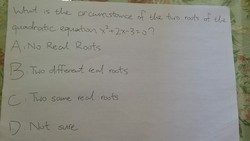Another Quadratic Equation Problem
 Choose an option from the question above.
Choose an option from the question above.
This section requires Javascript.
You are seeing this because something didn't load right. We suggest you, (a) try
refreshing the page, (b) enabling javascript if it is disabled on your browser and,
finally, (c)
loading the
non-javascript version of this page
. We're sorry about the hassle.
2 solutions
The given quadratic equation is x 2 + 2 x − 3
Finding solution to this equation is same as determining whether the p a r a b o l a of this equation intersects the X axis or not .
If the parabola does n o t intersect X axis then there are n o r e a l roots.
If the parabola has its vertex on X axis , then there are s a m e real roots.
If the parabola does intersect X axis at 2 d i s t i n c t points , then there are 2 d i f f e r e n t r e a l roots.
Since , leading coefficient of x 2 is + 1 , the parabola opens upwards.
If Δ = b 2 − 4 a c > 0 then , the parabola does intersect X axis at 2 distinct points giving 2 different real roots.
Here, Δ = 2 2 − ( 4 ) ( 1 ) ( − 3 ) = 4 + 1 2 = 1 6 > 0
Hence , there are 2 different real roots.
nature of the roots is determined by the formula b^2 - 4ac. if b^2 - 4ac >0, then roots are real and distinct if b^2 - 4ac=0, then roots are real and equal if b^2 - 4ac<0, then roots are imaginary
b^2 - 4ac = 2^2 - 4(1)(-3) = 16 hence roots are real and distinct